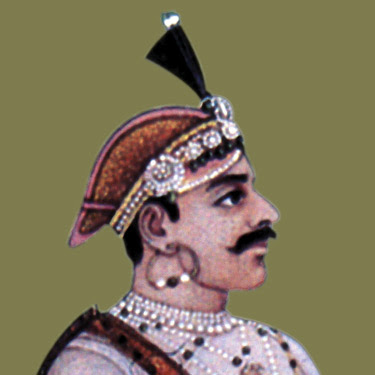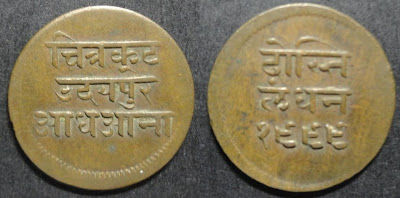Udaipur quarter anna
 Date: 2000 VS=1943 AD
Date: 2000 VS=1943 ADUdaipur kingdom/princely state (also called Mewar) is a region of south-central Rajasthan state in western India. It includes the present-day districts of Bhilwara, Chittorgarh, Rajsamand, Udaipur, and some of the part of Gujarat and Madhya Pradesh. The region was for centuries a Rajput kingdom that later became a princely state under the British. It was ruled by the Chattari rajputs of Mori Guhilot Parihar and Sisodia dynasties for over 1,400 years.
The legend on obverse reads "chitrakoot Udaipur" and the legend on reverse reads "Dosti Landhan" which means friends of London, as these were struck when Udaipur was a princely state under allegiance to the British rule, and below that we have the date in VS.
The legend on obverse reads "chitrakoot Udaipur" and the legend on reverse reads "Dosti Landhan" which means friends of London, as these were struck when Udaipur was a princely state under allegiance to the British rule, and below that we have the date in VS.
The above coins were minted during the reign of Maharana Bhupal Singh of Mewar:
Maharana Bhupal Singh
 Maharana Bhupal Singh who succeeded Fateh Singh formally ascended the gaddi in 1930 had been exercising power since 1921 as a result of British intervention. Maharana Bhupal Singh as the ruler of Mewar guided its destiny through India’s most momentous period, the Independence from British Imperial rule With a vision to lead in an age of turbulence. Like Rana Pratap’s heroic defence against the Mughals, Maharana Bhupal Singh’s vision was born out of a deep sense of patriotism and pride in upholding the core values of Suryavanshi Kings.The Maharana’s personal courage at all times exemplified the triumph of the human spirit as he was leading while still Confined to a wheelchair with a crippling spinal disorder.
Maharana Bhupal Singh who succeeded Fateh Singh formally ascended the gaddi in 1930 had been exercising power since 1921 as a result of British intervention. Maharana Bhupal Singh as the ruler of Mewar guided its destiny through India’s most momentous period, the Independence from British Imperial rule With a vision to lead in an age of turbulence. Like Rana Pratap’s heroic defence against the Mughals, Maharana Bhupal Singh’s vision was born out of a deep sense of patriotism and pride in upholding the core values of Suryavanshi Kings.The Maharana’s personal courage at all times exemplified the triumph of the human spirit as he was leading while still Confined to a wheelchair with a crippling spinal disorder.He was aware of the dynamic social changes sweeping across the country and encouraged the orderly growth of social and political movements. Like his famous ancestors who introduced reforms in the field of education, the Maharana established the Rana Pratap Hindi University at Chittor and an Agricultural College at Udaipur. Schools, especially for girls, were set up. He reformed the judicial powers in his state. He also paid a lot of attention to irrigation works and began the construction of the Bhupal Singh Dam. By 1935, he had set up fifteen dispensaries in various parts of his town. He reformed the local coinage also.
He was also a committed environmentalist, organising long-term afforestation programmes for the Aravalli Hills. Sustained industrial activity made the Mewar economy more vibrant in his reign. The modern exploitation of the long known and famous Zawar mines rich with their zinc, silver and lead content began during his reign. With Independence, came Maharana Bhupal Singh’s finest hour. The ruler, who stood to lose the entire governance of his kingdom, became the first State to merge with the indian Union. His historic words echoed the glory of Rana Sanga and Rana Pratap: “Today is a day of which to be greatly proud. India is independent. It brings to fulfilment the 1500 years’ struggle and endeavour of my forefathers. It becomes my holy duty, on behalf of my ancestors, to hand over to the leaders of free India, this cherished and sacred Flame of Freedom to the country as a whole.”
Maharana Bhupal Singh, acting honourably as the Diwan of Eklingji, served the interests and welfare of his people even though it spelt the end of Mewar’s sovereignty, which began with Guhaditya and was proudly defended for 1500 years. The grateful Government of India nominated him as “Maharaj Pramukh”, the only title of its kind in whole of India .





This comment has been removed by the author.
ReplyDeleteI HAVE 50 COINS. DO YOU THINK IT HAS ANY VALUE
ReplyDeletejitu.sant@gmail.com
What price do you want per coin?
ReplyDelete